Maintaining the optimal performance of a diesel engine requires vigilance, and one crucial aspect to monitor is the presence of blow-by. Blow-by, the leakage of combustion gases past the piston rings into the crankcase, can be indicative of underlying issues that may compromise engine efficiency.
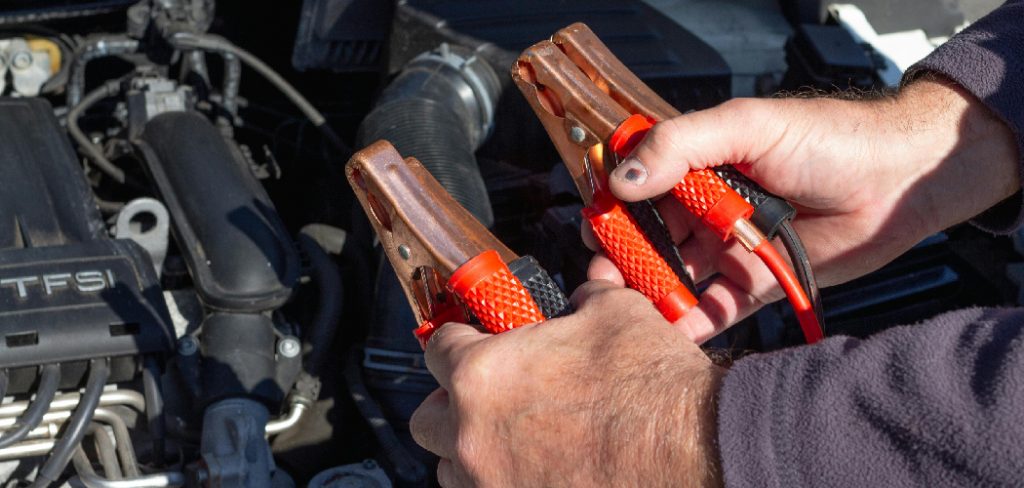
Recognizing the signs of blow-by and understanding how to check for blow by on a diesel engine owners and mechanics alike. In this guide, we will delve into the intricacies of identifying and assessing blow-by in a diesel engine.
From simple visual inspections to more advanced diagnostic methods, learning how to check for blow-by empowers individuals to detect potential problems early on, ensuring the longevity and reliability of their diesel-powered vehicles or machinery.
Importance of Checking for Blow by On a Diesel Engine
Regularly checking for blow-by is critical in maintaining the health of a diesel engine. Ignoring the symptoms of blow-by can lead to reduced engine performance, increased oil consumption, and potentially severe engine damage. Early detection through routine inspection can prevent costly repairs and unscheduled downtime, especially in commercial settings where diesel engines are indispensable.
In addition, identifying blow-by early helps to ensure that emission levels remain within regulated standards, fostering environmental responsibility. Thus, the significance of checking for blow-by extends beyond maintenance; it is also about operational reliability, cost-efficiency, and environmental care.
Understanding Blow By
Blow-by occurs when gases from the combustion chamber escape past the piston rings and into the crankcase. This happens when the piston rings, which seal the combustion chamber from the crankcase, lose their sealing effectiveness.
Several factors can contribute to blow-by, including ring wear, ring sticking, cylinder wall wear, or an accumulation of carbon deposits. Understanding blow-by is imperative as it not only affects engine performance but can also lead to increased oil contamination and crankcase pressure.
This can result in oil leaks, decreased lubrication, and damage to engine components. Recognizing the nuances of blow-by enables owners and technicians to address the root cause of the issue before it escalates into more significant engine concerns.
Exploring the Phenomenon of Blow-By
When discussing the phenomenon of blow-by, it is essential to dive deeper into the mechanics of what occurs during this process. Within a diesel engine, the combustion process generates high-pressure gases that are intended to drive the piston downward, translating explosive energy into mechanical motion.
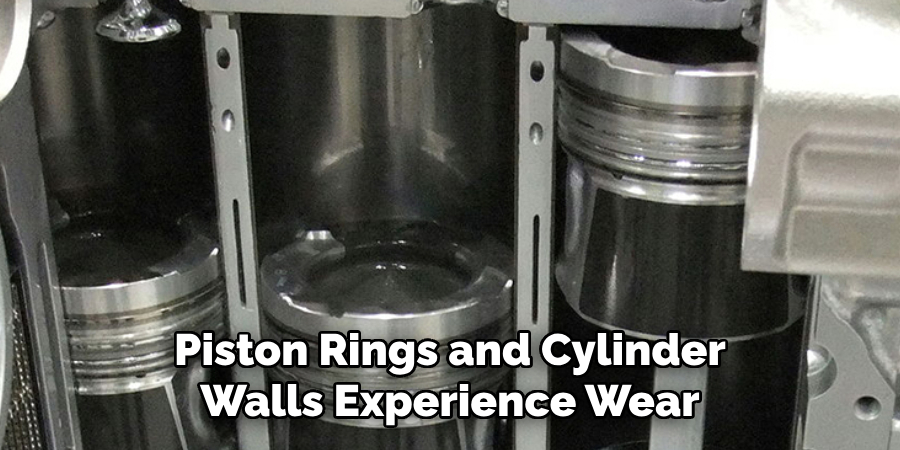
However, when piston rings and cylinder walls experience wear or are compromised, these gases exploit any gaps available, bypassing the seal and entering the crankcase. This dire passage of combustion gases results not just in power loss – as not all of the combustion force is applied to the piston – but also contaminates the engine oil and increases internal pressures.
This elevation in crankcase pressure can further provoke oil to be pushed out through seals and gaskets, causing leaks and accelerating wear on engine components. Understanding blow-by as a signal of deterioration enables timely interventions that can avert extensive damage to the diesel engine.
Causes of Blow-By in Diesel Engines
Blow-by in diesel engines can be triggered by a variety of factors, each contributing to the degradation of the engine’s performance. The most common cause is wear and tear on the piston rings, which lose their ability to form a tight seal against the cylinder walls over time.
Additionally, the cylinder walls themselves can become worn or scored, allowing gases to pass more easily. Accumulation of carbon deposits from incomplete combustion can also cause the piston rings to stick, preventing them from sealing properly.
Improperly seated or broken rings, excessive engine load, and using incorrect grades of oil can all exacerbate the issue of blow-by. It is crucial for engine maintenance to understand these causes, as addressing them directly is key to preventing further engine damage and maintaining optimal engine functionality.
Effects of Blow-By on Engine Performance
Blow-by can have several detrimental effects on the performance of a diesel engine. Initially, it may manifest as a mere decline in power output, but as the condition worsens, there can be a significant drop in fuel efficiency and overall engine power due to decreased compression in the cylinders.
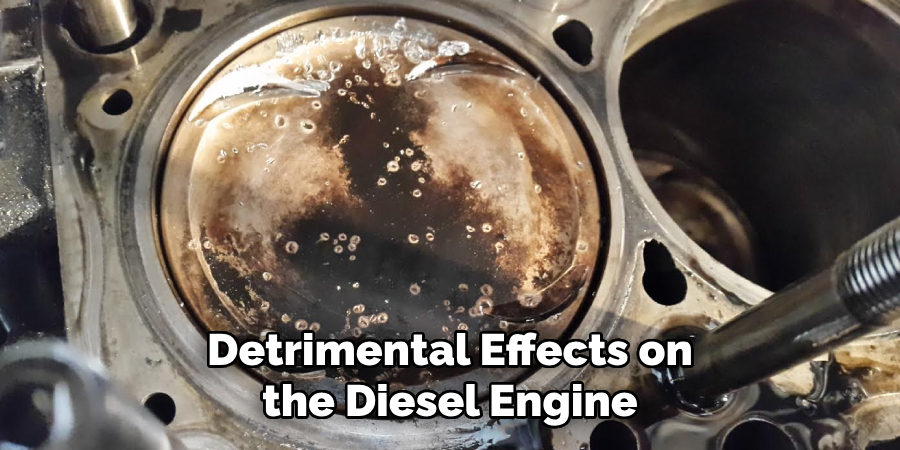
Elevated crankcase pressure can force oil and oil mist into the intake system, reducing the effectiveness of lubrication and causing the engine to burn oil, which may be observed as blue smoke from the exhaust.
Contaminated oil loses its properties faster, leading to increased friction and further wear on internal components. Moreover, blow-by gases that make it into the oil can cause the formation of harmful acids and sludge, which further reduce the lifespan of the engine. As such, the ripple effect of untreated blow-by can result in a cascade of engine problems that compromise vehicle performance and longevity.
Signs and Symptoms of Blow-By
Detecting the signs of blow-by early on is critical for diesel engine maintenance. One of the most obvious symptoms is the presence of smoke or mist emanating from the crankcase breather or the oil fill cap, indicating that combustion gases are entering the crankcase.
Additionally, engine operators may notice a decrease in power, acceleration, and fuel efficiency. Another indicator is excessive oil consumption, as blow-by can cause oil to burn or leak. Upon inspecting the oil, there may be evidence of contamination, such as a milky appearance or increased levels of soot and acids.
Users might also observe higher than normal crankcase pressure, which can force oil through seals and result in noticeable leaks around the engine. It’s important to remain vigilant for these signs, as they could herald more serious engine issues that require immediate attention.
10 Methods How to Check for Blow by on a Diesel Engine
1. Visual Inspection of the Oil Filler Cap:
Begin by inspecting the oil filler cap while the engine is running. If the cap vibrates or has visible smoke emanating from it, it could be an early indication of blow-by. Excessive pressure in the crankcase forces oil vapors out through the filler cap, signaling potential issues.
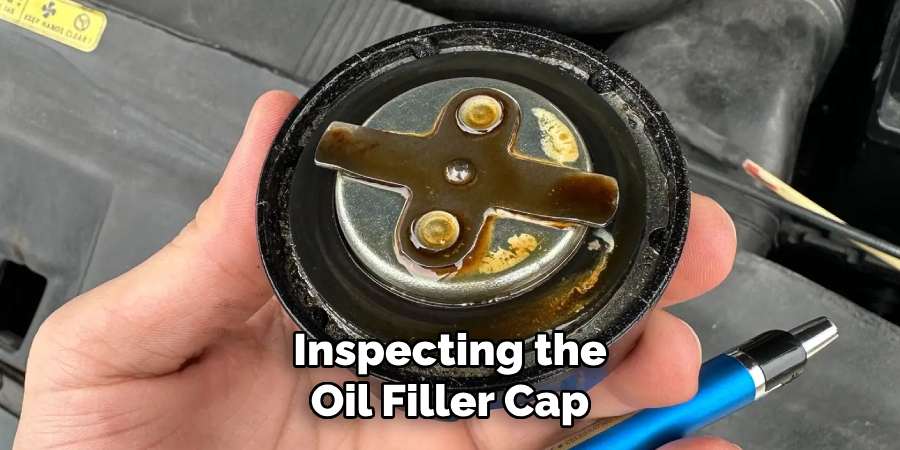
One possible cause of this issue could be a clogged PCV valve. The PCV (Positive Crankcase Ventilation) valve is responsible for regulating the pressure in the crankcase and directing excess vapors back into the engine for combustion.
If the oil filler cap appears to be in good condition, remove it and check for any unusual smells or discoloration on the underside. This could indicate contamination of the oil by coolant or fuel, which would require further investigation.
2. Checking Crankcase Ventilation System:
Evaluate the crankcase ventilation system, including hoses and valves, for any signs of damage or blockages. A malfunctioning ventilation system can contribute to increased pressure in the crankcase, leading to blow-by. Ensure all components are in good condition and functioning as intended.
It is important to regularly check and maintain the crankcase ventilation system to prevent potential engine issues. In addition to inspecting for damages or blockages, checking the hoses and valves can also help identify any leaks that may occur in these components.
Another factor to consider when evaluating the crankcase ventilation system is its efficiency. Over time, dirt and debris can accumulate in the system, clogging it and reducing its effectiveness. This can result in an increase of harmful emissions being released into the environment.
3. Using a Rubber Glove Test:
Conduct a simple yet effective rubber glove test by placing a glove securely over the oil filler cap opening while the engine is running. If the glove inflates, it indicates pressure buildup and blow-by. This method provides a quick visual confirmation of potential issues.
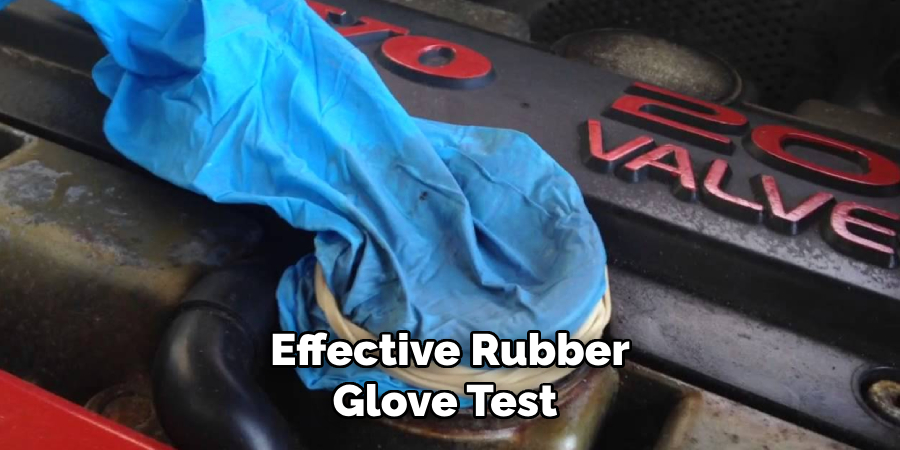
Another way to perform a rubber glove test is by placing the glove over the tailpipe while the engine is running. If the glove inflates, it could indicate an issue with the exhaust system or piston rings.
Performing this test regularly can help identify potential issues with your vehicle’s engine and exhaust system before they become major problems. It is a simple and easy way to keep track of the health of your vehicle and prevent costly repairs down the road.
You can also use other methods to check for blow-by, such as a vacuum gauge or compression test. These tests provide more accurate measurements but require specialized tools and knowledge.
4. Observing Exhaust Smoke:
Pay attention to the color and density of the exhaust smoke. Excessive white or blue smoke, especially during acceleration, may suggest oil being burned in the combustion chamber due to blow-by.
Such smoke patterns can be indicative of internal engine problems. Black smoke, on the other hand, could indicate a rich air-fuel mixture or a clogged air filter. In diesel engines, black smoke may also be caused by worn injectors or an overloaded engine.
Some light-colored exhaust smoke can be normal during cold weather conditions as condensation forms in the exhaust system and is released when the engine warms up. However, if the smoke persists or increases, it could be a sign of a leaking head gasket or cracked cylinder head.
In these cases, it is important to have the engine checked by a mechanic as soon as possible to prevent further damage.
5. Measuring Crankcase Pressure:
Utilize a crankcase pressure gauge to directly measure the pressure inside the crankcase. Connect the gauge to the oil filler cap or another accessible point. Abnormally high pressure readings may signify blow-by issues, prompting further investigation into the engine’s internal condition.
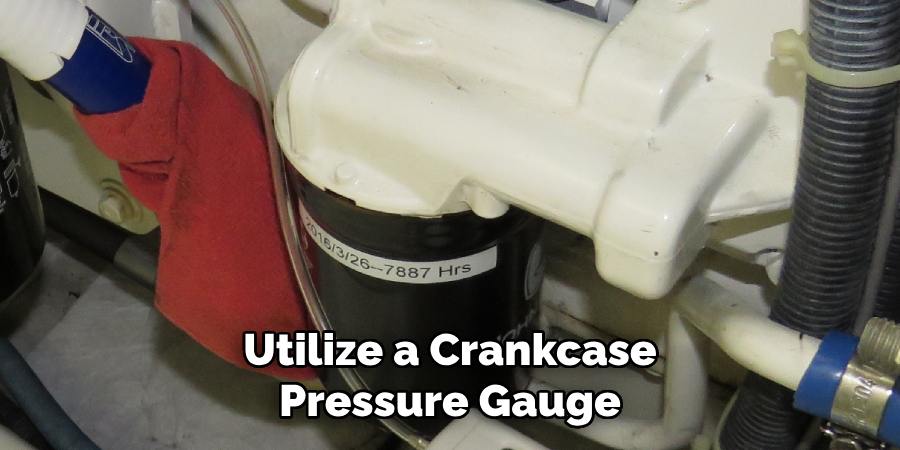
Additional content: In addition to measuring crankcase pressure, it is also important to regularly check the level and condition of the engine oil. Low oil levels or dirty oil can lead to increased friction and wear on internal engine components, potentially causing higher crankcase pressures.
Regularly changing the engine oil and using high-quality, recommended oil can help maintain proper crankcase pressure levels and prolong the life of the engine.
6. Compression Test:
A compression test provides insights into the engine’s overall health and can uncover issues contributing to blow-by. Measure the compression in each cylinder, comparing the results to manufacturer specifications. Significant variations between cylinders may indicate worn piston rings or cylinder wall damage.
In addition to measuring compression, a compression test can also reveal problems with valves or head gasket leaks. Low compression in multiple cylinders may indicate a head gasket leak, while low compression in one cylinder may point to a damaged valve.
To perform a compression test, start by removing the spark plugs and disconnecting the fuel system. Then, attach a compression gauge to the first cylinder and have a helper crank the engine. Record the maximum compression reading for each cylinder, repeating the process for all cylinders.
7. Leak Down Test:
Perform a leak-down test to assess the efficiency of the engine’s internal seals. This involves pressurizing each cylinder and measuring the percentage of pressure loss. Excessive leakage may point to issues like damaged valves or worn piston rings contributing to blow-by.
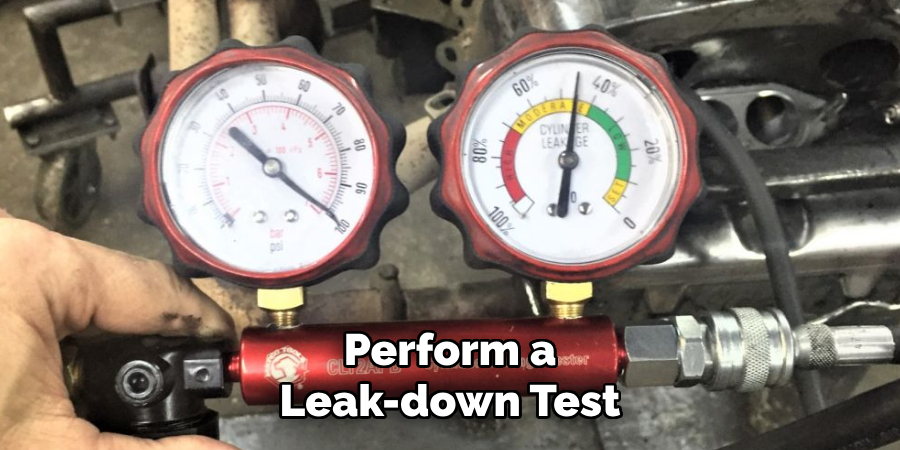
The leak-down test is an important diagnostic procedure that can reveal potential problems within the engine’s internal components. By pressurizing each cylinder and measuring the percentage of pressure loss, mechanics can pinpoint issues such as damaged valves or worn piston rings that may be causing excessive blow-by.
To perform a leak-down test, specialized equipment is needed, including a compressed air source and a leak-down tester. The engine must also be at operating temperature and in neutral gear before the test can begin.
8. Inspecting PCV (Positive Crankcase Ventilation) Valve:
The PCV valve plays a crucial role in maintaining proper crankcase ventilation. Inspect the PCV valve for signs of clogging, wear, or malfunction. A faulty PCV valve can disrupt the balance of pressure within the crankcase, potentially leading to blow-by. If left unchecked, this can cause serious engine damage. Though the PCV valve is a relatively inexpensive part, it is important to regularly inspect and replace as needed.
To inspect the PCV valve, first locate it on the engine. It is typically located on the valve cover or intake manifold. Once located, remove the valve from its housing. Inspect the valve for any signs of wear or damage such as cracks, breaks, or clogs. If any problems are detected, replace the valve with a new one.
Next, check the valve spring for proper tension. The spring should have enough tension to keep the valve closed when there is no vacuum present. Use a finger to push on the plunger of the valve and check if it easily moves in and out. If there is too much resistance or the valve doesn’t move at all, the spring may need to be replaced.
9. Using a Manometer:
Employ a manometer to measure the vacuum level in the crankcase. Excessive vacuum may indicate a restriction in the crankcase ventilation system or other issues contributing to increased pressure. A balanced and stable vacuum reading is indicative of a healthy crankcase.
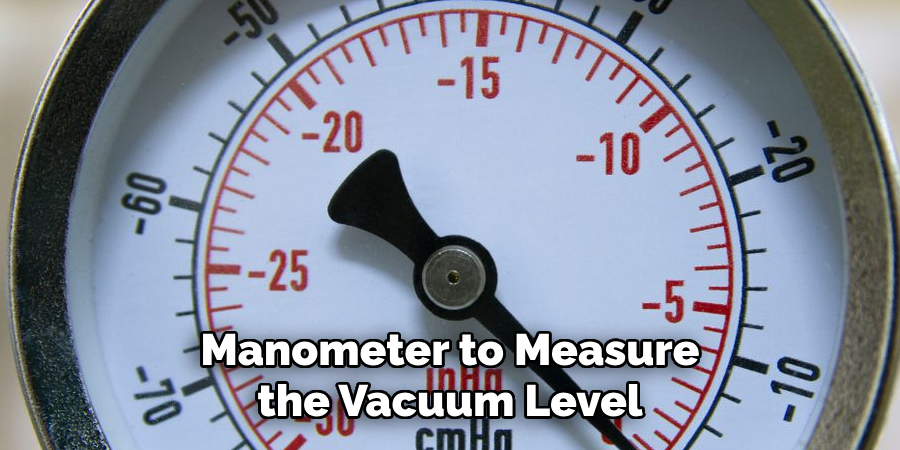
Using a manometer is a simple and effective way to measure the vacuum level in the crankcase. This tool consists of a U-shaped tube filled with liquid, such as mercury or water, connected to the engine’s intake manifold.
To use a manometer, first make sure your engine is turned off and has cooled down. Then locate the intake manifold, which is usually a metal tube attached to the engine. Find the vacuum line connected to the intake manifold, and remove it from the manifold.
Next, connect one end of the manometer tube to the vacuum line and seal it tightly with a clamp or rubber tubing. The other end should be left open.
10. Oil Analysis:
Regular oil analysis can provide valuable insights into the presence of contaminants and excessive wear particles, both of which may result from blow-by. Analyzing the composition of the engine oil can help detect early signs of internal engine problems contributing to blow-by.
In addition, oil analysis can also help determine whether the correct type of oil is being used in the engine. If the wrong type of oil is being used, it can cause excessive wear and tear on engine components leading to increased blow-by.
Oil analysis typically involves collecting a sample of the engine oil and sending it to a laboratory for analysis. The sample is then examined under a microscope to determine the presence of contaminants and abnormal wear particles. By analyzing the chemical composition of the oil, experts can also identify any potential issues with the engine’s internal components.
Conclusion
In conclusion, understanding how to check for blow by on a diesel engine is essential for maintaining its performance and longevity. By recognizing the signs and symptoms of blow by, conducting visual inspections, and performing diagnostic tests such as crankcase pressure and compression tests, owners can identify potential issues early on.
Interpreting test results and troubleshooting abnormalities allow for timely intervention and necessary repairs. Moreover, implementing regular maintenance practices to prevent blow by, such as timely oil changes and engine tune-ups, helps ensure optimal engine health. Thanks for reading, and we hope this has given you some inspiration on how to check for blow by on a diesel engine!

About
JeepFixes Team is a skilled author for Jeep Fixes, bringing 6 years of expertise in crafting a wide range of jeep fixes. With a strong background in jeep fixes work, JeepFixes Team’s knowledge spans various types of fixtures, from decorative pieces to functional hardware, blending precision with creativity. His passion for jeep fixes and design has made him a trusted resource in the industry.
Professional Focus:
Expert in Jeep Fixes : JeepFixes Team aesthetic specializes in creating durable and innovative jeep fixes, offering both appeal and functionality. His work reflects a deep understanding of jeep fixes techniques and materials.
Sustainability Advocate : He is dedicated to using sustainable practices, ensuring that every fixture is crafted with eco-friendly methods while maintaining high-quality standards.
In his writing for jeep fixes, JeepFixes Team provides valuable insights into the latest trends, techniques, and practical advice for those passionate about jeep fixes, whether they are professionals or DIY enthusiasts. His focus on combining artistry with engineering helps others discover the true potential of jeep in design.
